What started years ago as just a collection of trails between isolated Nepali villages in the mountains has turned into one of the most popular, iconic treks in all of Nepal: the Annapurna Circuit. If you are planning a trip to Nepal and have 2-3 weeks to trek, I recommend the Annapurna Circuit Trek (it’s better than Everest Base Camp!).
You’ll be rewarded with changing scenery every day: from snow-capped mountains, rivers and waterfalls and glaciers. There are fields of yaks and goats, and villages covered in colorful prayer flags fluttering in the wind. You’ll meet and stay with local Nepali families at their guesthouses, eat meals with trekkers from around the world and make many new friends.
To reach the highest point of the Annapurna Circuit, Thorong La Pass, is a great physical feat that you’ll remember for the rest of your life.
Here’s all you need to know before you embark: your Ultimate Guide to the Annapurna Circuit Trek!
Skip to Ultimate Guide to the Annapurna Circuit Section:
Overview
Guided vs Unguided
Duration
Itinerary Samples
Getting To and From the Circuit
Insurance
Permits
Food & Accommodation
Budget & Money
Packing List
WiFi/SIM card
Safety Concerns
Comparison to Everest Base Camp
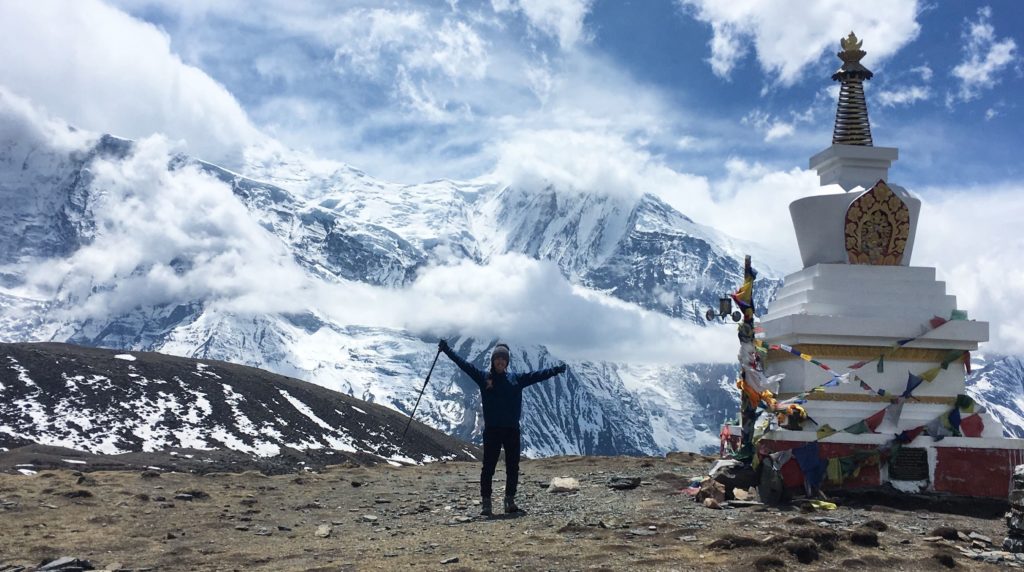
Overview of the Annapurna Circuit Trek
Duration: 8 – 21 days (depends on transportation used – see Duration section below)
Change in Altitude: 790m at Besisahar to 5416m at Thorong La Pass
Distance per day: 10+ km
Total Distance: 230 km from Besisahar to Birethani
Best season: April-May, September-November
Budget: $20 USD or 2000 rupees/day. At low altitude, $5-7/day. At high altitude, $25-$30/day
See my full packing list here!
The landscape on the Annapurna Circuit changes from lush greenery and Nepali agricultural fields at low altitude, to rocky riverside valleys and snowy mountain tops at high altitude. Sometimes the trail opens up to wide plains, where you can see the Annapurna mountain range and glacier formations in the distance.
If you’re at low altitudes during the right time of the year, there’ll be a lot of colorful wildflowers. At higher altitude you’ll be above the tree line, so there are small bushes and shrubs along side you, with yaks grazing nearby. You may also experience trekking through snow at 4000m+.
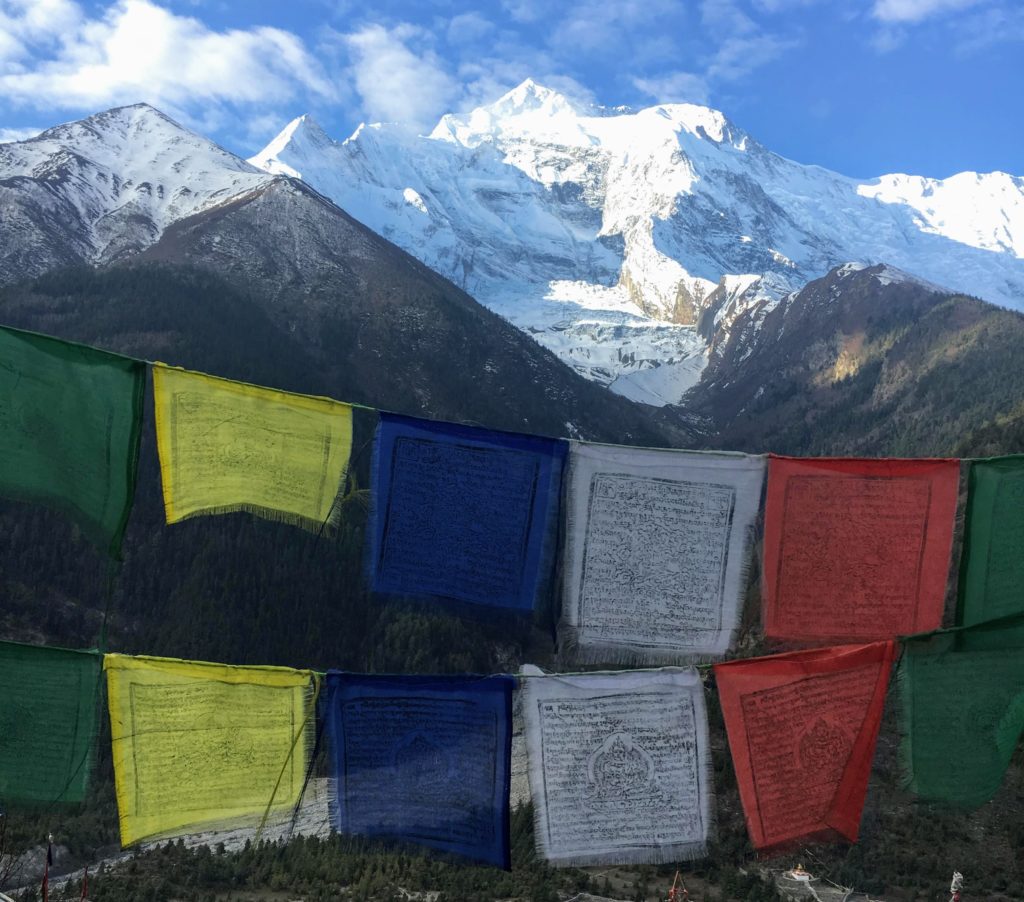
Trekking the Annapurna Circuit Guided vs Unguided
I trekked the Annapurna Circuit unguided, and I think it’s safe to do so. The entire trek follows a river that’s dotted with villages, so you’re never far from civilization. There are almost always locals or trekkers nearby who can point you in the right direction if you get lost. The trails are clearly marked, and you can follow maps.me trails to double check if you’re going the right way.
Getting a guide is helpful if you’re really worried about losing your way. A guide can also explain to you more about the local people and traditions of the region, give you accurate estimates on how far and for how many hours you’ll be trekking that day. Guides can also communicate with guesthouse owners for you about meals and accommodation, but I experienced little language barrier in the mountains.
Annapurna Circuit hiking tip: Be sure to meet your guide before you start the trek! Guide quality and experience varies greatly.
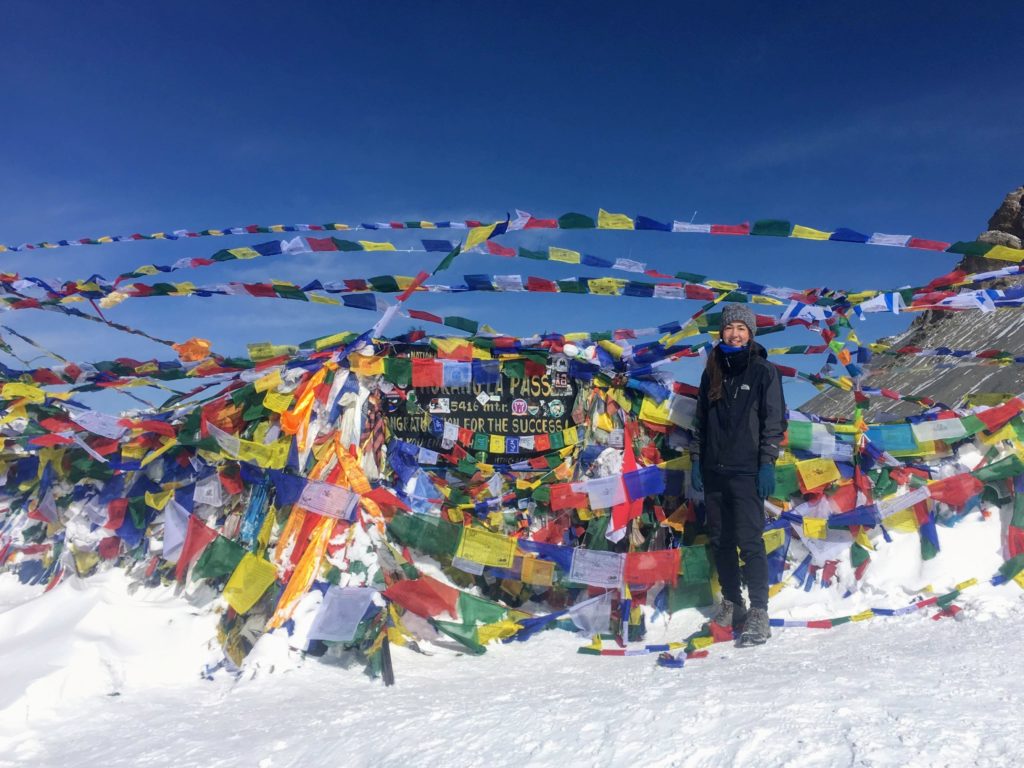
Duration
Most people who trek the entire Annapurna Circuit could complete it in 14-21 days. However the duration depends on the side treks you want to do, and the distance you want to cover each day.
Theoretically you can do just the highest altitude section of the Annapurna Circuit in 8-10 days, if you jeep up to Chame, then Jeep back down from Jomsom. This increases the chances of getting altitude sickness because your body has very little time to adjust to the high altitude. I personally don’t recommend it, also because you skip some beautiful sections of the trek, but for those on a tighter schedule this may be an option.
I trekked the Annapurna Circuit in 13 days because I started in Tal, and sped through the last section to Nayapul after Khagbeni. This included an acclimatization day in Manang, and a detour to Khagbeni after Thorung La pass. The group of trekkers I hiked with started in Tal then took a jeep down from Jomsom, so they were trekking the Annapurna Circuit for 10 days.
A woman on the trail was doing every single side trek possible because she was loving the Annapurna range so much. She was on day 30 when I met her outside of Tatopani!
Annapurna Circuit 8-day, 13-day, and 18-day Itinerary Samples
Annapurna Circuit 8-day sample itinerary
Day 1: Pokhara -> Besisahar (bus) -> Chame (jeep)
Day 2: Lower Pisang/Upper Pisang
Day 3: Bhraka/Manang
Day 4: Manang (acclimatization day)
Day 5: Yak Kharka
Day 6: Thorung Pedi
Day 7: Muktinath
Day 8: Jomsom -> Pokhara (jeep)
Annapurna Circuit 13-day sample itinerary (this is how I trekked the Circuit)
Day 1: Pokhara -> Besisahar -> Tal (jeep)
Day 2: Koto/Chame
Day 3: Lower Pisang/Upper Pisang
Day 4: Bhraka/Manang
Day 5: Manang (acclimatization day)
Day 6: Yak Kharka
Day 7: Thorung Pedi
Day 8: Muktinath
Day 9: Khagbeni
Day 10: Larjung
Day 11: Tatopani
Day 12: Ghorepani
Day 13: Poon Hill side trek -> Birethani -> Pokhara (bus)
Check out my more detailed 13-day itinerary here!
Annapurna Circuit 18-day sample itinerary (Full Circuit plus Tilicho Lake side trek)
Day 1: Pokhara -> Besisahar (bus) -> Bhulbhule
Day 2: Jagat
Day 3: Danakyu
Day 4: Chame
Day 5: Lower Pisang/Upper Pisang
Day 6,7: Bhraka/Manang (acclimatization day)
Day 8: Tilicho Lake Base Camp (side trek)
Day 9: Tilicho Lake/TIlicho Lake Base Camp (side trek)
Day 10: Yak Kharka
Day 11: Thorung Pedi
Day 12: Muktinath
Day 13: Khagbeni
Day 14: Marpha
Day 15: Ghasa
Day 16: Tatopani
Day 17: Ghorepani
Day 18: Poon Hill side trek -> Birethani -> Pokhara (bus)
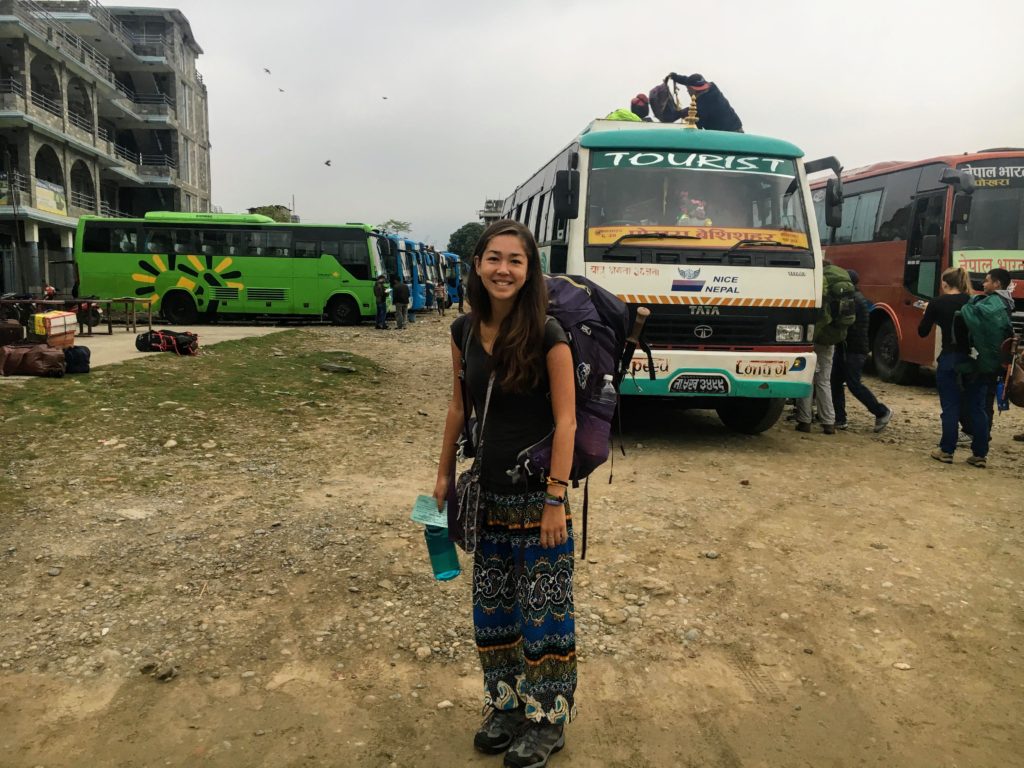
Getting To and From the Annapurna Circuit
Getting to Besisahar from Pokhara/Kathmandu
To get to the Annapurna Circuit, you’ll take a bus from Pokhara or Kathmandu to a village called Besisahar.
From Pokhara, you can take a bus from the tourist bus station to Besisahar (book a ticket in advance, and negotiate on the price) for 500-600 rupees. The bus leaves once per day at 6:30am and takes about 5 hours.
To get from Kathmandu to Besisahar, a microbus that leaves at 6:45am from the front of BG mall. It takes about 7 hours can costs 550 rupees ($5.50). Alternatively, you can catch any tourist bus heading to Pokhara from Kathmandu and ask to be dropped off at Dumre. From there, catch the local bus or a taxi to Besisahar.
*Bus schedules may change so ask any tourist agency to point you to where you can catch these busses!
Ultimate Guide to the Annapurna Circuit Tip: Once you reach Besisahar, there are many jeeps that take people up to a higher elevation starting point on the Annapurna Circuit such as Tal or Chame.
Getting back to Pokhara from Nayapul
The “finish line” of the Circuit is Birethani, after which there is a 30 minute walk to Nayapul.
From Nayapul you can take the local bus back to Pokhara for 120-200 ($1-$2) rupees. There are also many taxi drivers waiting to take trekkers back to Pokhara.
If you prefer, you can spend 2-3 days walking back from Birethani to Pokhara because there are many villages in between.
Insurance
Just in case you encounter serious altitude problems while you’re on the trek, make sure you have traveler’s insurance.
Ultimate Guide to the Annapurna Circuit Tip: It’s important to check if your insurance will cover you up to 5416m in elevation also – many will have an elevation limit that’s below 5000m!
World Nomads insurance allows you to purchase insurance with them even when you’re already abroad. They have a “Standard” insurance plan and an “Advanced” one for extreme sports/traveling activities and high altitude!
Permits for the Annapurna Circuit
There are two different permits that you need to purchase before departing on the trek, the TIMS and the Trekking permit. There is nowhere on the Circuit where you can buy these, so you need to go to the tourist office in Kathmandu or Pokhara ahead of time. There are a multitude of checkpoints along the entire circuit, so don’t try to trek the Annapurna Circuit without these permits!!
You can get your TIMS and Trekking permit in Kathmandu or Pokhara. I got mine in Kathmandu – the office is about an hour walk away from Thamel. The tourist office in Pokhara is near the tourist bus station, which is a short taxi ride from the main part of town known as Lakeside Pokhara.
Bring at least 4300 rupees with you, and 4 passport photos to get your permits for the Annapurna Circuit trek. Passport photos can be purchased at many stores around Thamel. I got 8 small pictures for 200 rupees ($2).
The TIMS costs $20 or 2000 rupees, and the Trekking Permit costs $23 or 2300 rupees.
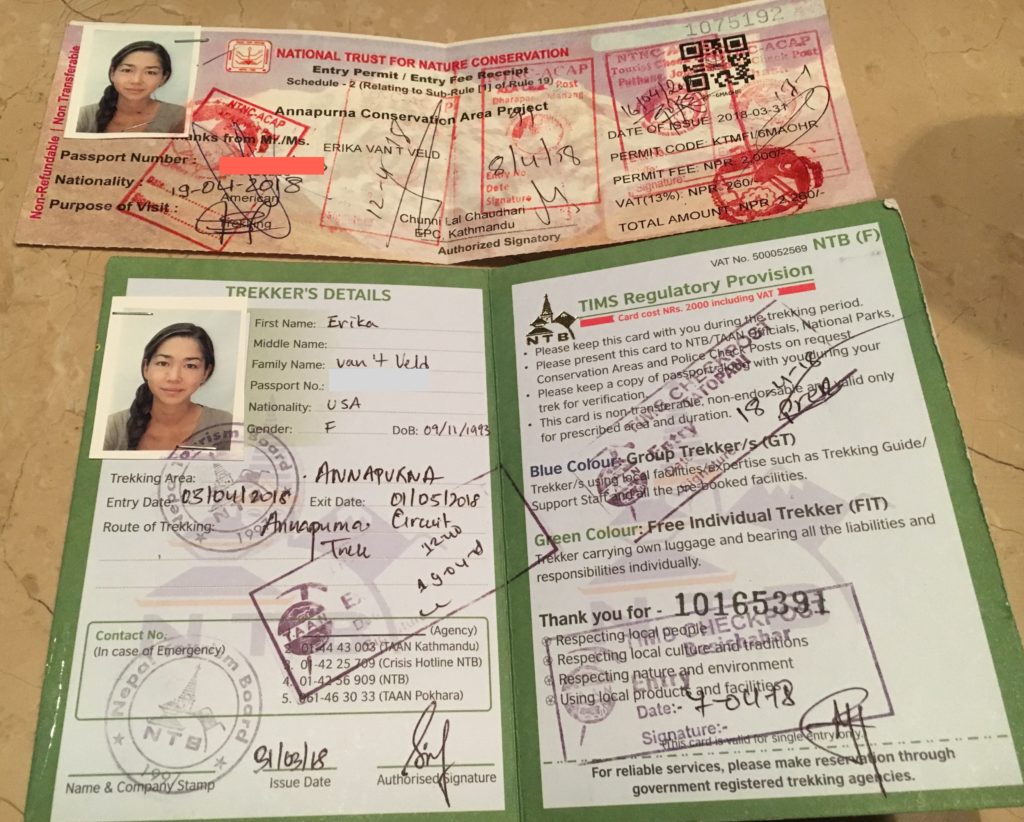
To fill out the permit forms, aside from personal and passport information, you need to include the following information to get the trekking permits. There’s no wifi at the Kathmandu office so make sure you have everything you need saved on your phone!
- Expected Trek Start Date and End Date (This can be approximate. It is best to overshoot how many days you think you’ll actually spend in the area)
- Expected Trek Start Location and End Location. For the Annapurna Circuit, it’s Besisahar to Nayapul (But I just put Pokhara for both, and had no issues)
- Insurance Policy Number (I didn’t have this on hand when I went to apply so I put a random string of numbers down that I found in an email with the insurance company, and had no issues.)
- Route of Trekking (Annapurna Circuit)
- Trekking Area (Annapurna Circuit or Annapurna Region)
- Purpose of Visit (Trekking)
Food and Accommodation on the Annapurna Circuit Trek
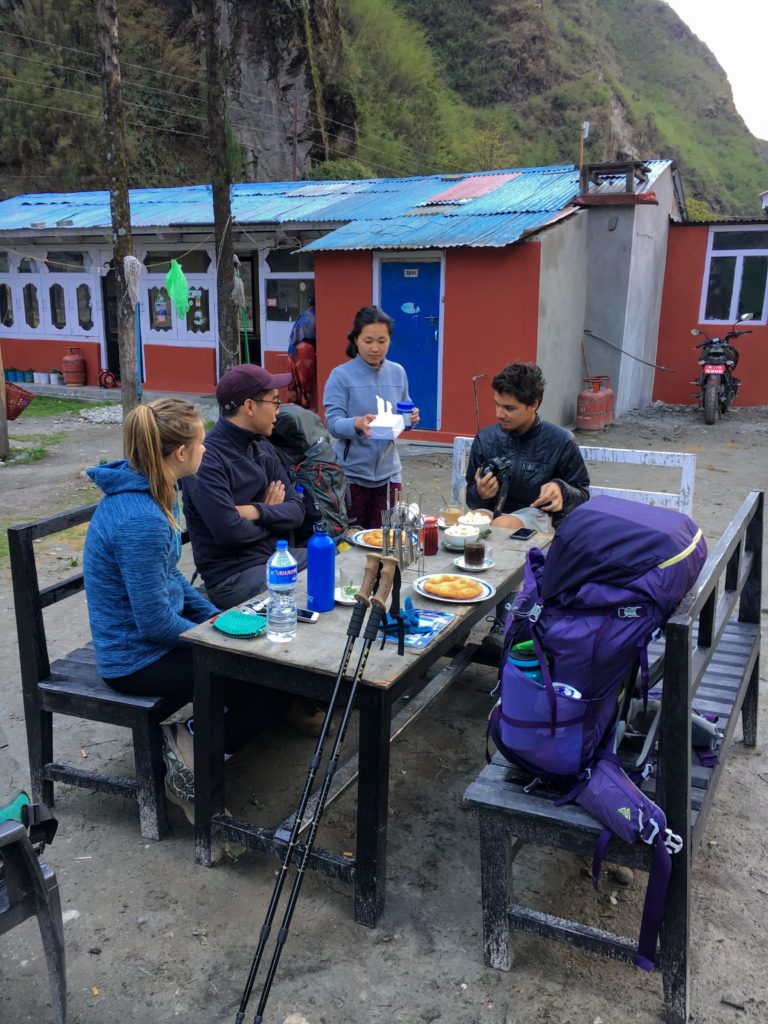
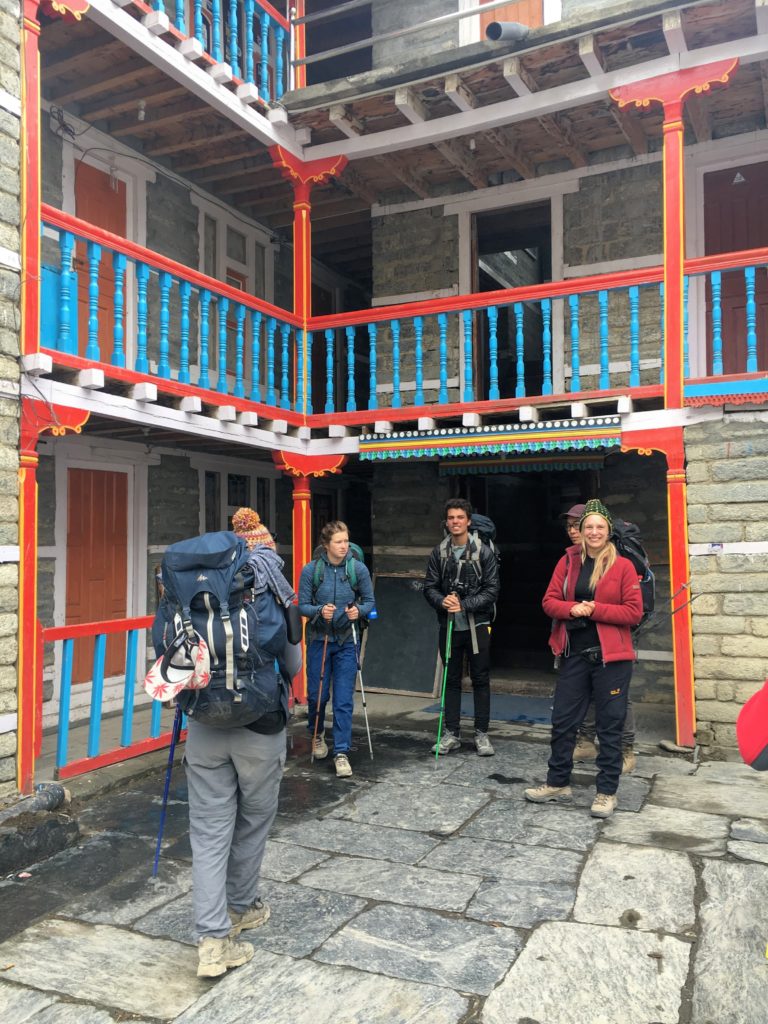
One of the many perks of trekking in Nepal is the teahouses or guesthouses that you’ll be staying in along the Annapurna Circuit!
Traditionally, trekkers stay for free at teahouses in exchange for eating meals there. Meals should include dinner after you arrive, and breakfast before you leave for the next day of trekking. In the villages on the Circuit there are rarely any restaurants that are not part of a guesthouse. So you would be taking your meals at the place you stay anyways. It’s a win-win!
Food
The typical Nepali dish that locals eat and is available at every guesthouse is Dal Baht – a curry and rice dish that usually includes an extra serving in the price!
Pasta, fried noodles, fried rice, pizza, noodle soups, and burgers are also standard dinner items at guesthouses when trekking the Annapurna Circuit. Breakfast options include yogurt with muesli, fried Tibetan bread, porridge, and pancakes.
Don’t expect to be able to cook for yourself along the trek. Since the guesthouses are letting you stay for free, you should really eat the food that they provide for you there. Lunch is a different story though, and you may be able to ask some places for 1 liter of boiled water if you wanted to make something easy like ramen noodles or oatmeal.
Accommodation
The majority of my accommodation on the Annapurna Circuit, I stayed for free. It’s easy to spot which buildings in the villages are the guesthouses because of signs outside their properties. When you find whoever manages the guesthouse, ask if they have rooms available. If they say yes, phrase your next question like this: “Can we stay for free if we eat dinner and breakfast here?”
Guesthouses on the Annapurna Circuit may charge 100-200 rupees for a room if you’re trekking solo, which I had happen to me on some occasions. If you stay in fancier, more hotel-like lodges, they may charge extra for a room as well. Large lodges will usually have a bit more luxury for the higher price you pay, such as an attached bathroom, a gas shower, and/or free, fast wifi.
What to expect:
Accommodation on the Annapurna Circuit range from having attached bathrooms in the rooms to shared toilet shacks out back, and from having nice thick, insulated walls to just planks of wood nailed between you and the outdoors. They’ll always have more duvet covers if you need them, sometimes at a premium.
The guesthouses always have a common room/restaurant area to take meals in or to chill out in until you retire for the night. These usually have a stove (powered by yak dung!) to heat the area, and sometimes there are benches around the kitchen stove where you can warm up as well.
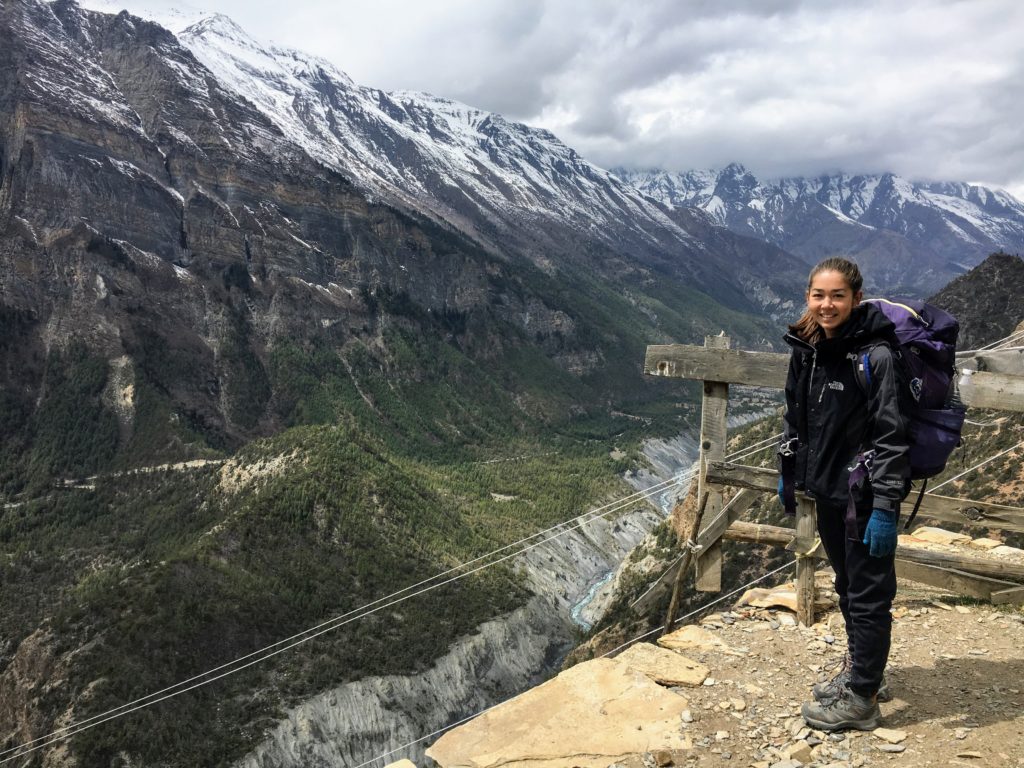
Budget & Money on the Annapurna Circuit
Ultimate Guide to the Annapurna Circuit Tip: Bring with you all of the money that you plan to spend on the Annapurna Circuit from Pokhara (or Kathmandu). There are plenty of ATMs in Pokhara to withdraw money from, but the only ATMs available on the Annapurna Circuit are in Jomsom, which is passed the halfway point of the Circuit.
I personally brought 40,000 rupees with me ($400), and only spent about 25,000 ($250) in 13 days. This does not include the cost for the permits (4300 rupees or $43), nor the cost for the gear that I bought in Kathmandu and Pokhara.
The cost for food and snacks changes drastically from the start of the trek at low altitude vs at high altitude. At the start of the trek I spent about $6-8 day, and close to Thorung La Pass I was spending $20 per day on the same meals and for accommodation.
Ultimate Guide to the Annapurna Circuit Budget: Bring about 2000 rupees ($20) per person per day. My Annapurna Circuit budget was $400 for 14 days, and I spent $250.
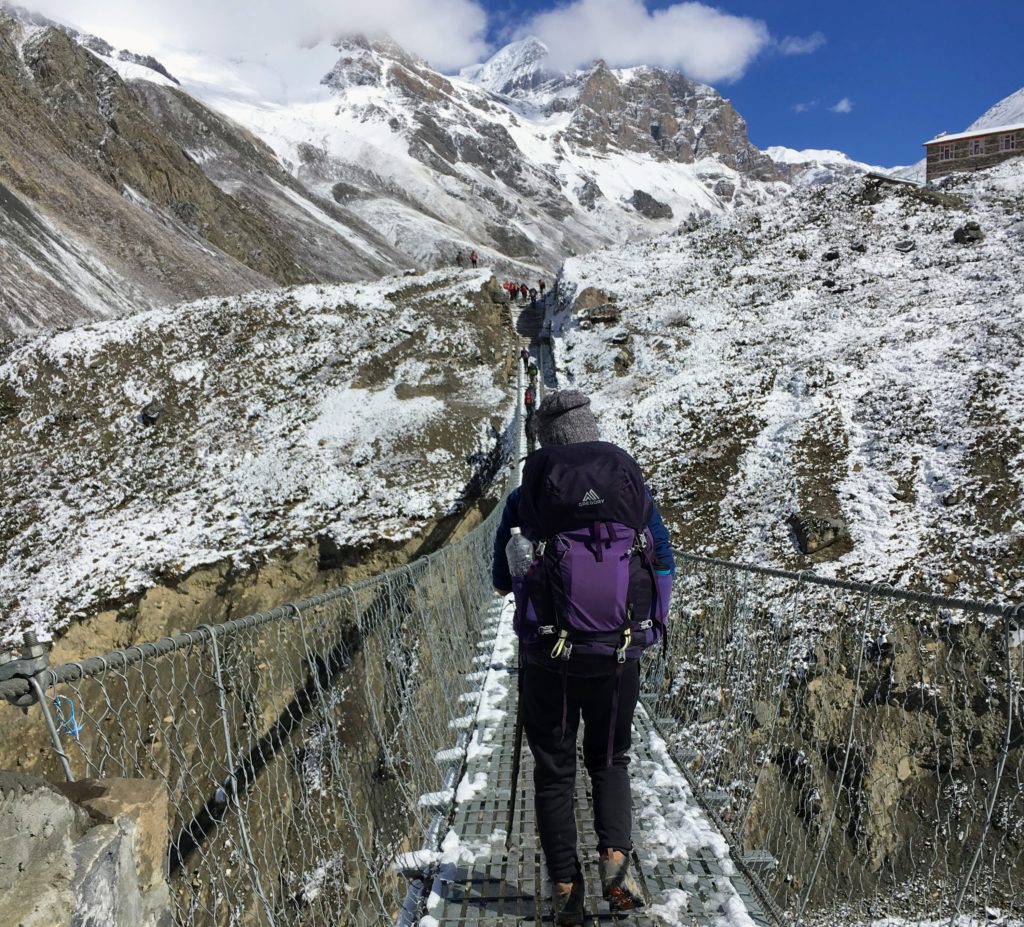
Packing List for the Annapurna Circuit
I’ll divide this section of my Ultimate Guide to the Annapurna Circuit into four different parts: Pharmacy, Clothing, Gear, and Other. This is a list of things that I brought on the Annapurna Circuit, minus things I didn’t wear or use.
Check out my full Trekking in Nepal Packing List!
Remember the goal is to be as efficient as possible when packing, so you don’t need to carry so much around with you.
Pharmacy:
Feminine products
16x Cough drops (wish I had brought more!)
10x Band-Aids
5x Rehydration Salts (Awful taste but really important)
1x Diamox strip (I didn’t use these but many people do)
1x Paracetamol strip
50x Water purification tablets (I used about 40 of these)
Sunscreen!
Deodorant
Toothbrush/toothpaste
Packet of baby wipes
Lotion
Razor
Hair ties
Toilet Paper
Clothing:
1x long-sleeved under armour
1x long-sleeved heat-tech shirt
1x long heat-tech leggings
1x thick under armor sweatpants
1x T-shirt
6x underwear
2x bras
3x thick trekking socks
1x normal socks
1x fleece
1x Goretex thick North Face jacket
1x thin windbreaker
1x thin gloves
1x thick gloves
1x hat
1x neck wrap
Gear:
1x 55-65L backpack
1 pair of mid hiking boots
1 pair of Chacos/trekking sandals
1 pair of trekking poles
1 pair of microspikes
Other:
Battery pack!!
Phone + charger
GoPro + charger
Kindle
Flashlight or Headlamp
Optional to bring:
Microspikes/Crampons
Knee braces (450 rupees from pharmacy in Kathmandu – these saved my life!)
Small day bag
Flip flops
Dry shampoo
Honey
Ear plugs
Snickers bars
Sunglasses
There are many hostels in Kathmandu and Pokhara that will let you leave your luggage at their hostel for a small daily fee, or even for free (I left a bag in Kathmandu’s Shantipur Hostel, then a second bag at Pokhara’s Pokhara Youth Hostel, both for free). It’s important to take advantage of these services, or else you’ll have a hell of a time hiking at 5400m with a 15kg bag!
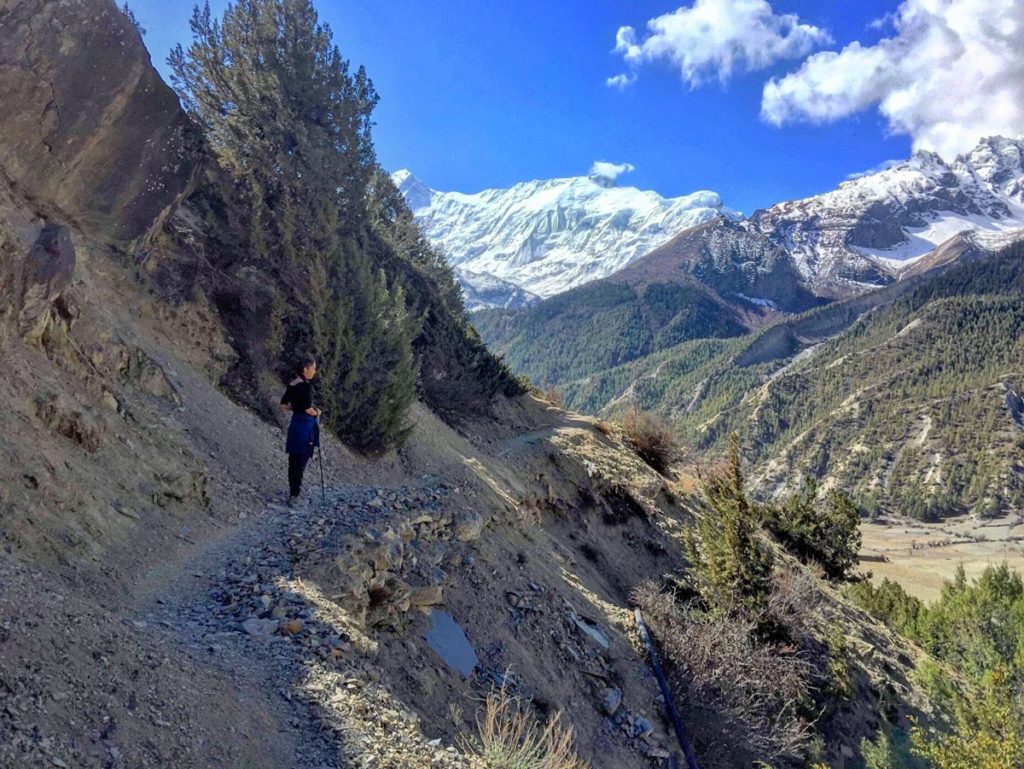
Wifi/SIM card
Before I left Pokhara, I messaged my family and friends saying that I would be without WiFi for the next 14 days, and not to worry if they don’t hear from me. Little did I know WiFi is a common luxury at guesthouses around the Annapurna Circuit!
Most guesthouses on the Annapurna Circuit have poor quality WiFi that you can use for free, or for a small fee per device. Don’t expect much, but it’ll be enough to send some messages to the outside world.
Before leaving Pokhara I purchased an NCell SIM card. It was 1500 rupees ($15) for 10 GB of data. I didn’t have service on most of the East side of the circuit before Thorong La Pass (but free Wifi was common). But I had service sporadically on the West side of the circuit, including in Muktinath, Jomsom, and Tatopani.
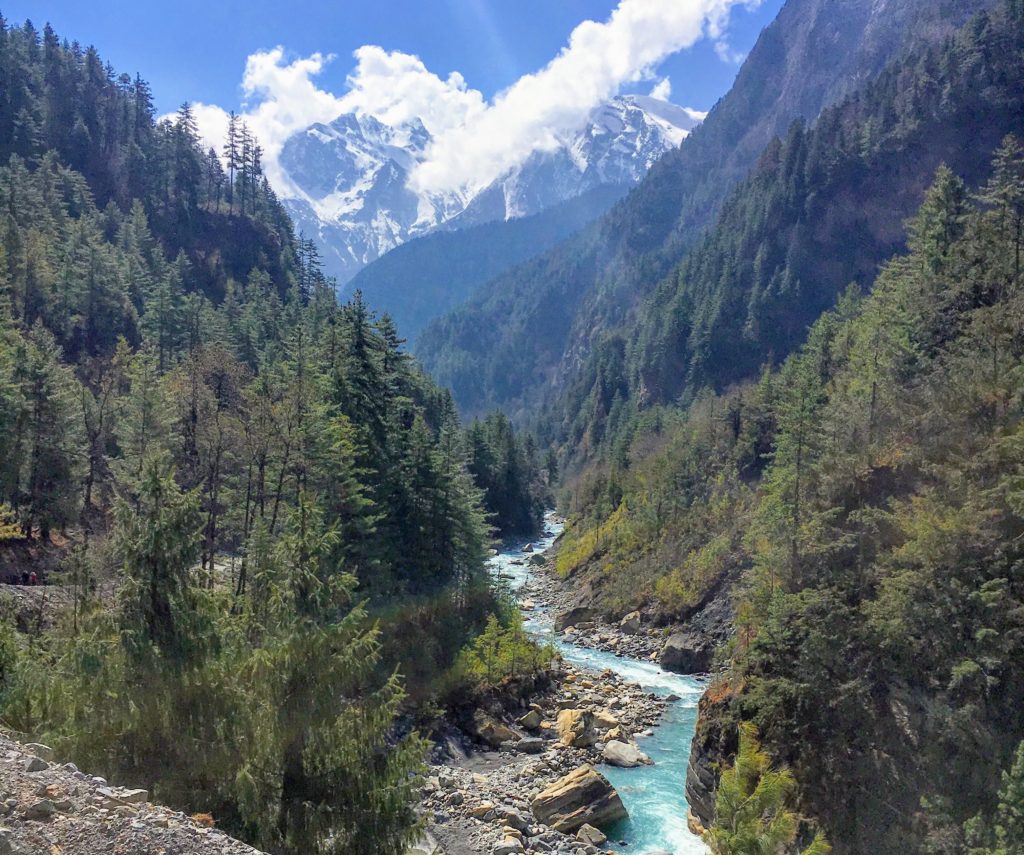
Safety Concerns on the Annapurna Circuit
I remember one sleepless night in Kathmandu where I thought about everything that could possibly go wrong on the Annapurna Circuit. Having finished the trek, let me assure you there is nothing to worry about! Skip down to any worries you might have and put your mind at ease.
Getting “Taken”/General women’s safety
Nepali people are so friendly along the Annapurna Circuit. On your first day, any worries about getting mugged, kidnapped, etc will disappear immediately. Think of all the solo female trekkers who did the Circuit before you and were fine! Unlike some parts of India, it’s common to see local women walking around alone everywhere, and they even run many of the guesthouses on their own or with their daughters.
Getting lost forever on the Annapurna Circuit
Not possible. The trails for the most part are clear to see and clearly marked. During the high season there will almost always be someone in the distance you can follow, or someone behind you who you can wait to ask for directions. The entirety of the trail goes alongside a river except for Thorong La Pass Day when everyone is bunched together in a group anyways. As long as you keep the river and other trekkers in sight you’ll know where the villages and civilization are.
Avalanches at Thorong La Pass
Not happening. The pass itself is very wide and the mountains on either side are far enough away that there is nothing of this sort to worry about. There are some sections where you walk over snow on a steep incline. If you’re worried about slipping, bring crampons!
Landslides
There are sections that have warnings about landslides. These occur for mostly if there is someone or something running around above you in a landslide area and rocks come loose.
Check above you if there are any goats or sheep before you cross a landslide section. If you’re walking across a landslide section, keep distance between you and the person in front of you. Walk on the inside of the trail. Remember that yaks and horses use these same trails. If they can make it without causing a landslide, so can you.
Freezing
Don’t worry. Your body will stay surprisingly warm while you’re trekking. I brought a pair of snow pants with me that I used only on Pass Day, but took off after an hour because I was getting too hot. When you arrive at the guesthouse your body temperature will start to drop, so huddle up in your sleeping bag or next to the heater in the common area.
Snow and extreme weather
If it’s blizzarding outside, it’s best to wait until it clears, to continue on the Annapurna Circuit. The only day where I had to trek through snow for a significant amount of time was on Pass Day, and still the path was obvious. If the weather starts to change at the top, ask any of the guides what is best to do. Worst case scenario, there’s a warm tea shop next to Thorong La Pass where you could wait out a storm.
Not being able to find a guesthouse
The villages along the Annapurna Circuit are covered in guesthouses. Sometimes there are random guesthouses dotted along the trails as well. If you are trekking outside of the high season, you will have no problem finding a room at a guesthouse along the Annapurna Circuit.
If you are trekking in October without a guide, it might be a good idea to start trekking early to beat the others. And if all of a town’s guesthouses are full, it’s never too far to the next village. Some guesthouses may let you stay with your own sleeping bag in their common area too.
Altitude Sickness
Almost everyone experiences some form of altitude sickness while on the Annapurna Circuit, but they are mostly just mild nuisances. If you take it slow on the Annapurna Circuit and always listen to your body, serious altitude sickness won’t be an issue.
Signs of acute altitude sickness include headache, dizziness, nausea, and shortness of breath. There are other symptoms like tingling in the hands and face.
If any of these symptoms worsen, it’s a good idea to take a rest day, or drop altitude and wait for it to get better. The human body is damn tough, and it will adjust along the trail to the lower oxygen levels as long as you are giving it time to do so.
If you think your body will be prone to altitude sickness, take some Diamox pills with you. I didn’t use these, but many people took them every day once they reached 4000m or above. Consult your doctor before you take any sort of medication!!
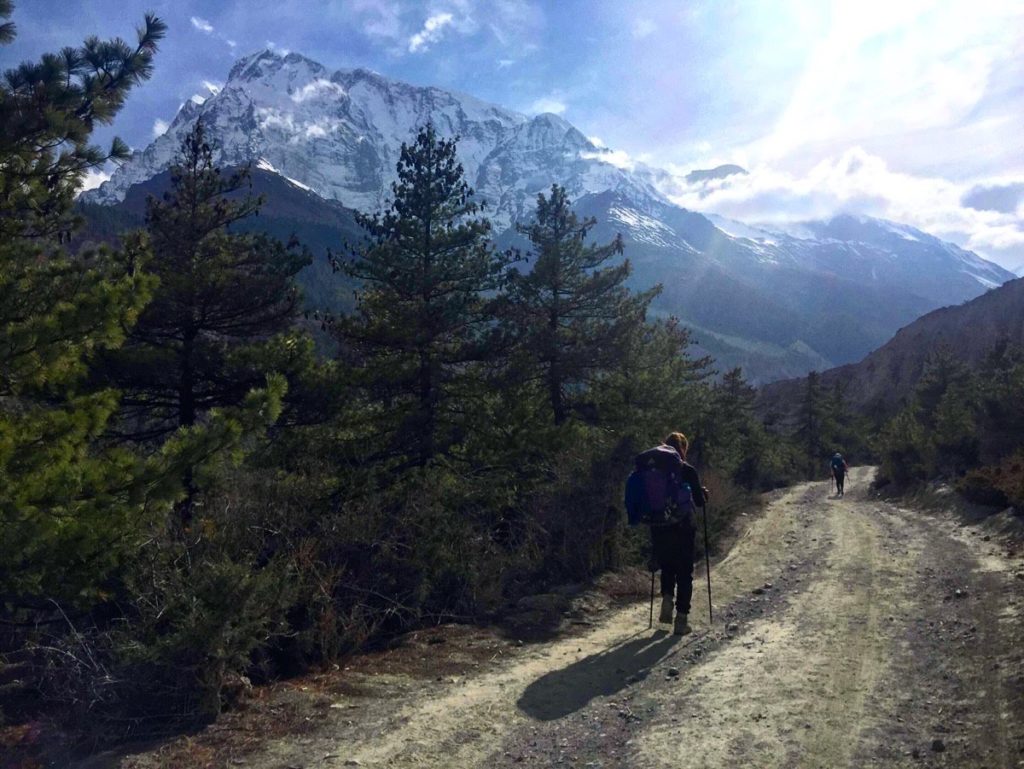
Comparing the Annapurna Circuit vs Everest Base Camp
Annapurna’s competing iconic trek in Nepal is the Everest Base Camp Trek. In terms of duration, it takes a similar amount of time to complete (12-16 days) and you’ll experience a similar climate as the Annapurna Circuit. In terms of the trekking experience, the Annapurna Circuit and Everest Base Camp treks are quite different. If you only have time for one, I recommend the Annapurna Circuit over Everest Base Camp trek.
See my blog post comparing the Annapurna Circuit Trek vs the Everest Base Camp Trek!
Alternatively, if you are choosing between the Annapurna Circuit and the Three Passes Trek + EBC, I would choose the Three Passes Trek because of its epicness!! This trek is more off-the-beaten-path, and takes you to higher elevations and greater views than the EBC trek alone does. Check out the vlog by Intrepid Road about the Three Passes Trek!
In Conclusion...
The Annapurna Circuit was one of the most rewarding, beautiful treks I’ve ever done in my life (and I grew up in the Rocky Mountains!). To spend so many days in the wilderness but not have to worry about food and a bed at the end of the day gives you a chance to enjoy nature and reflect on your life in a way that only Nepal can offer.
What are you waiting for?? Get your packing list together and go!
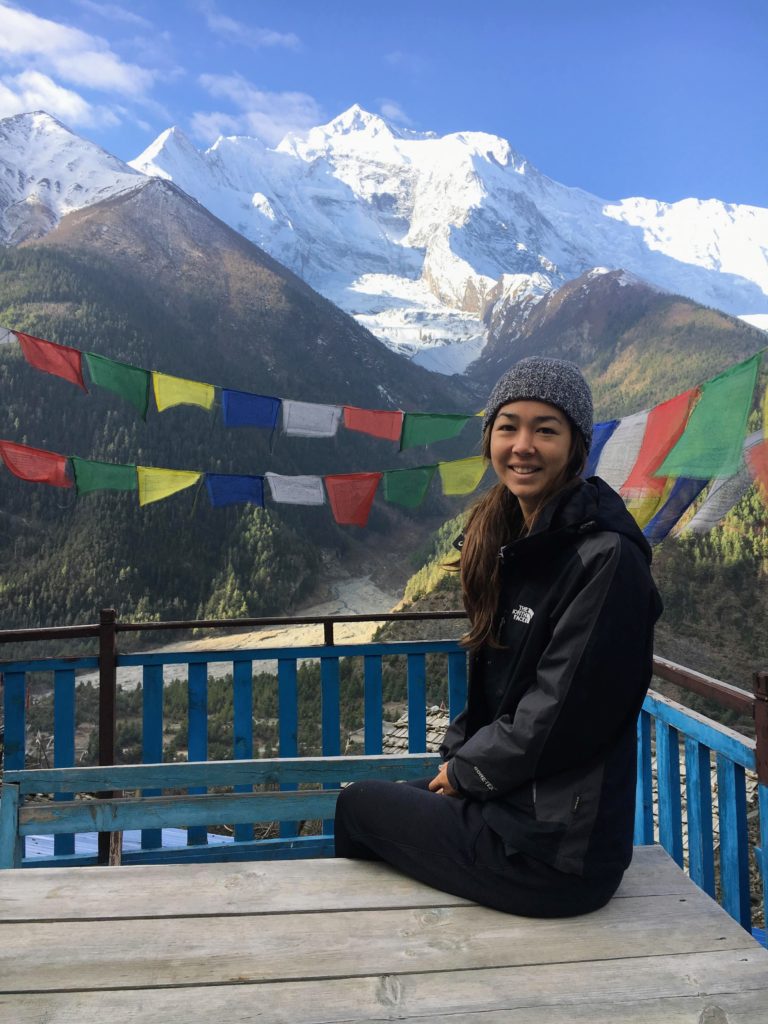
Pin this Annapurna Circuit Ultimate Guide for later!
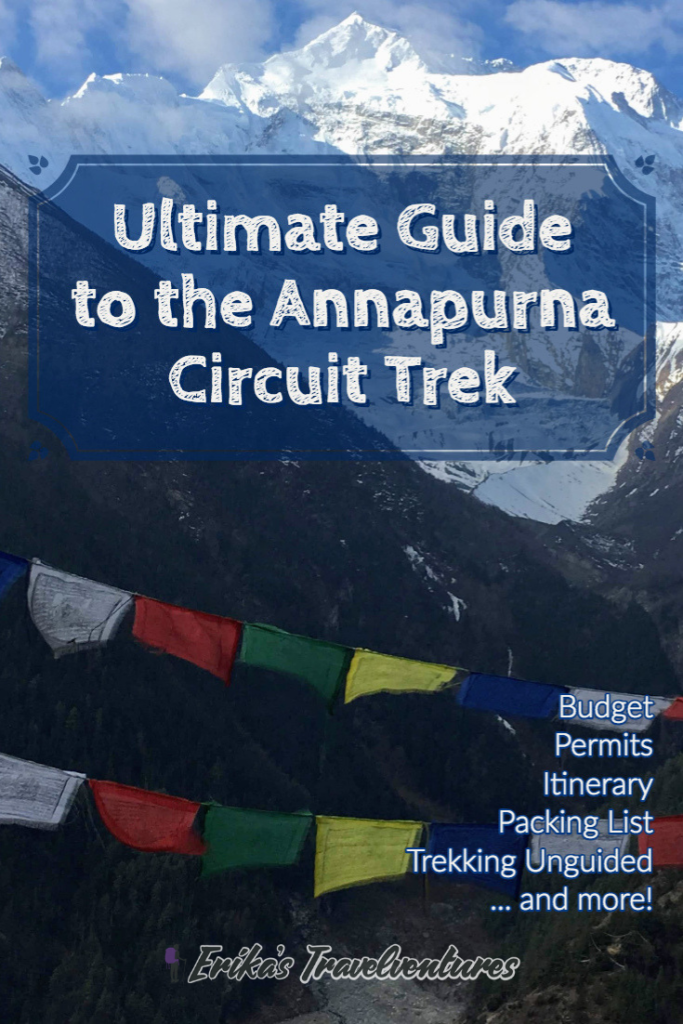
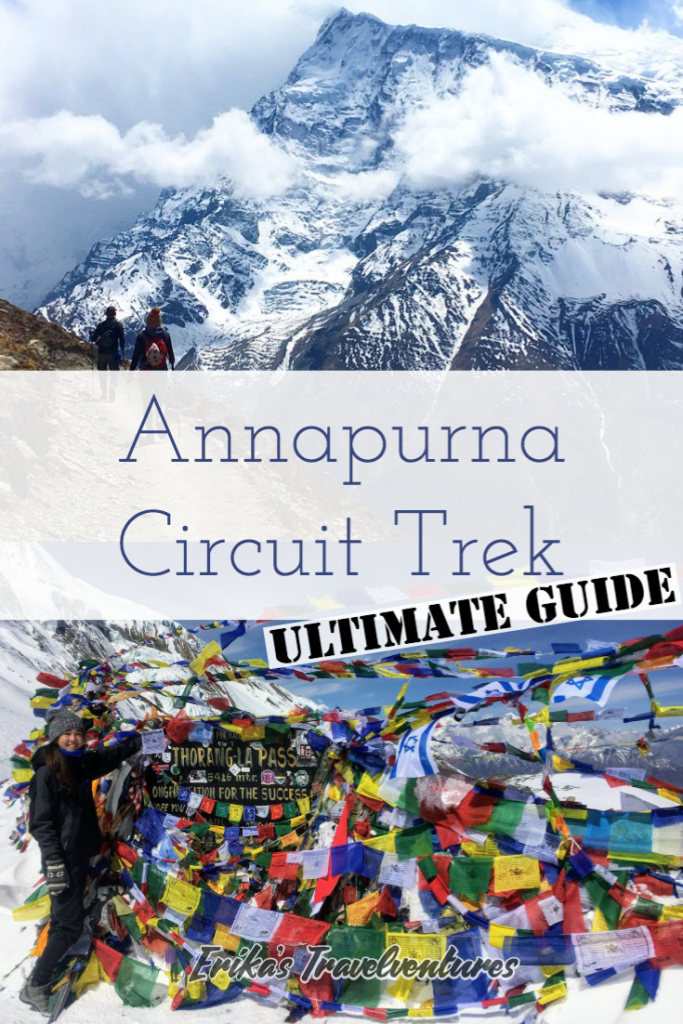
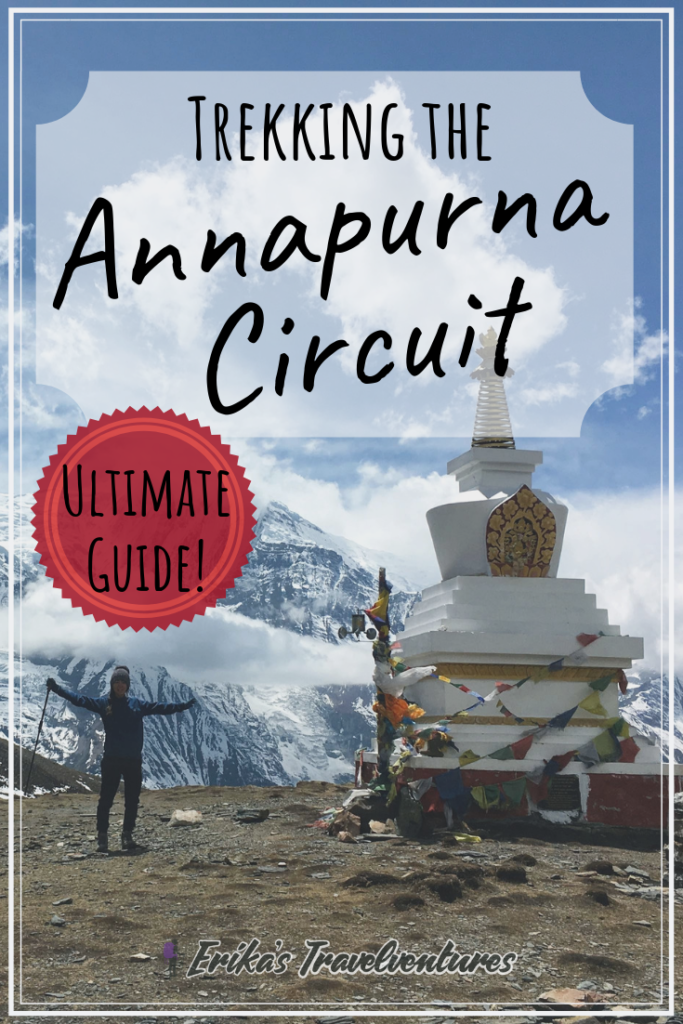
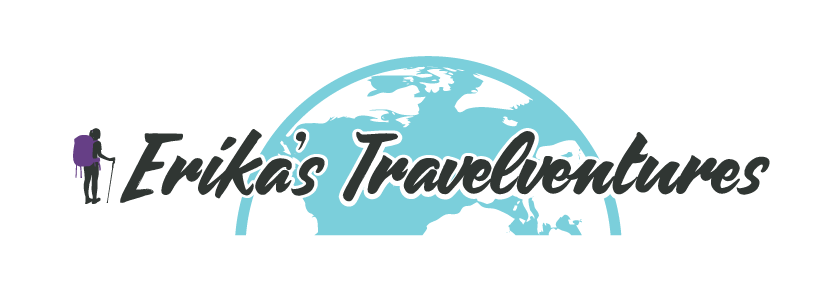
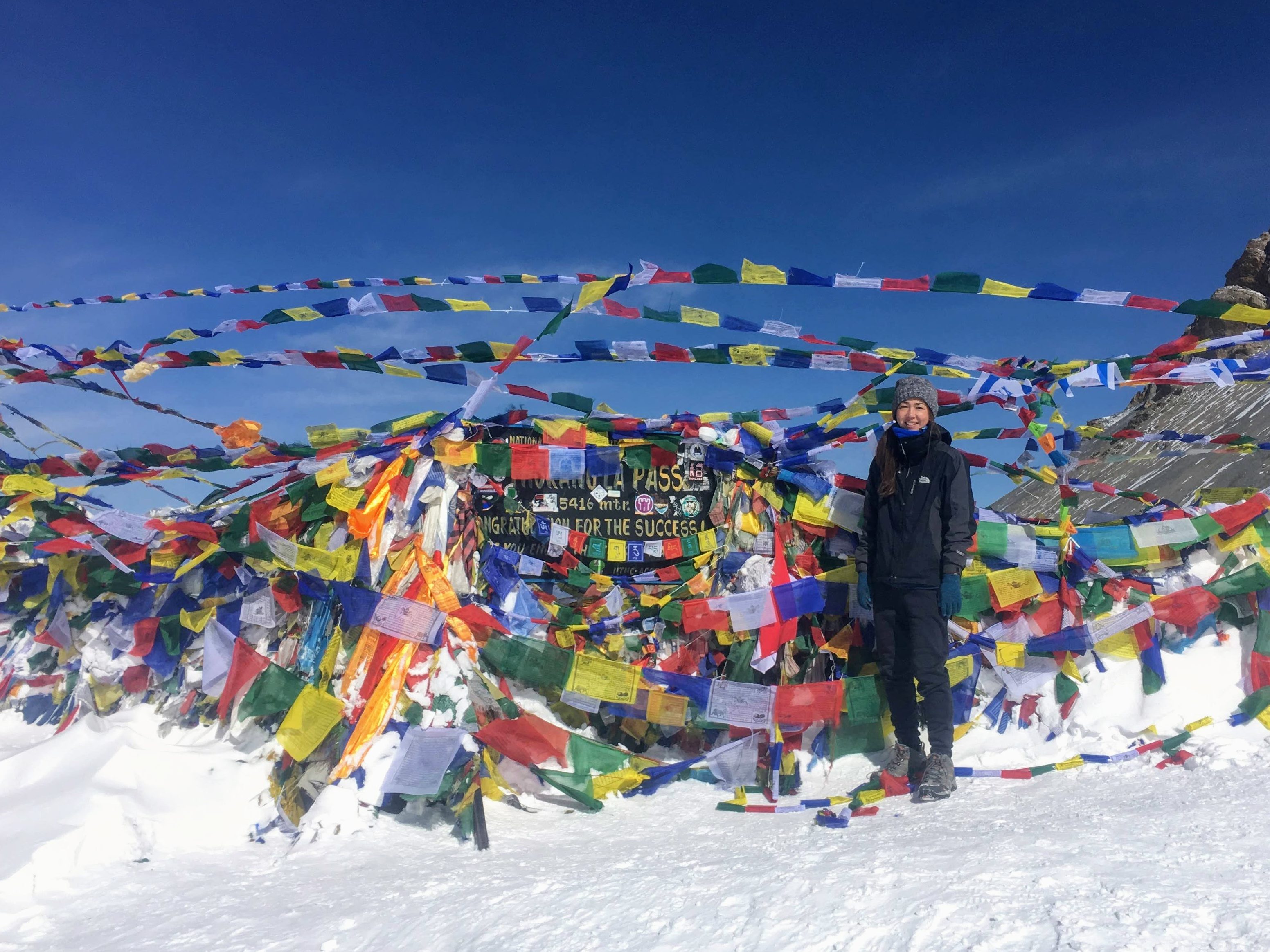

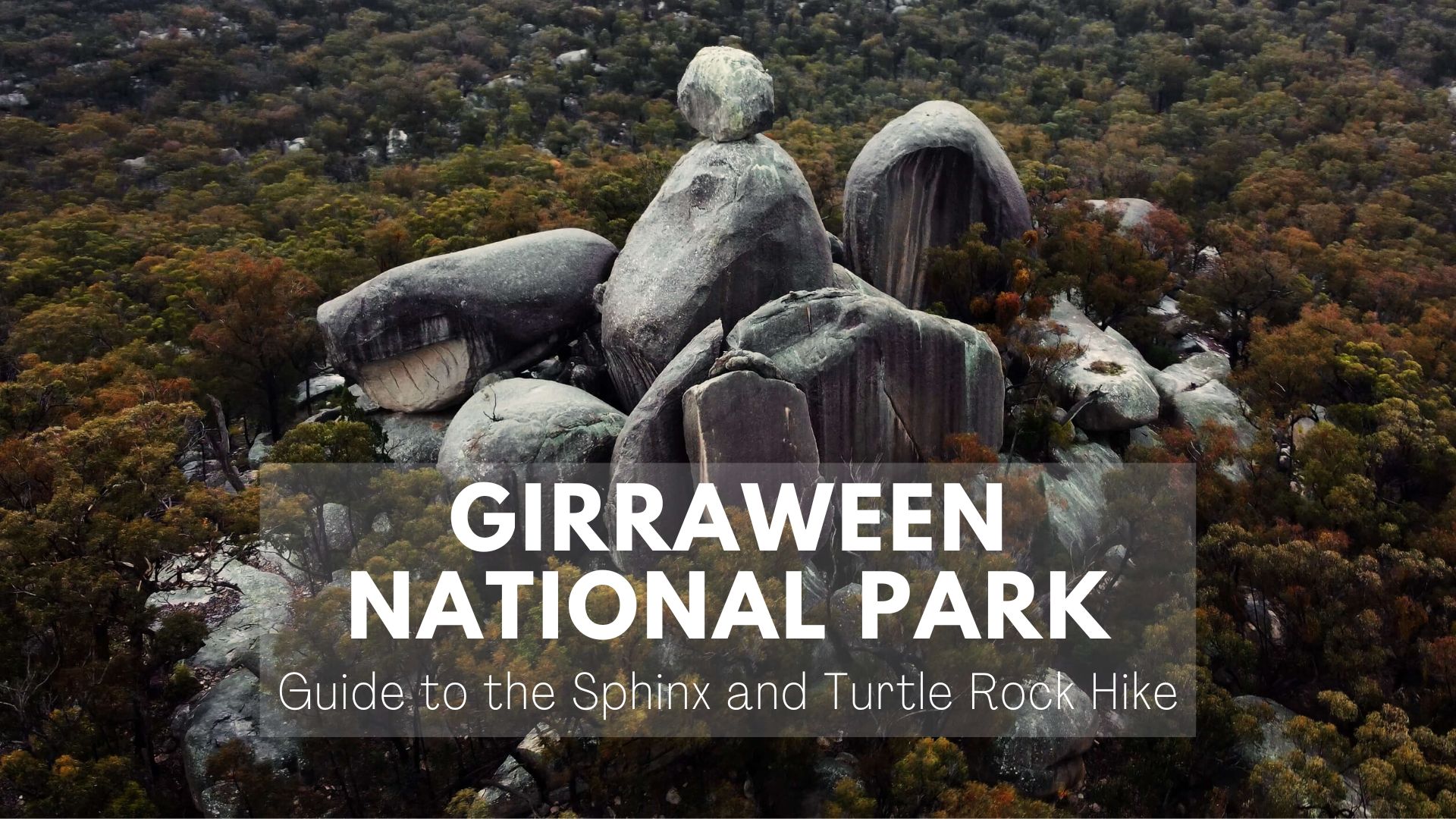
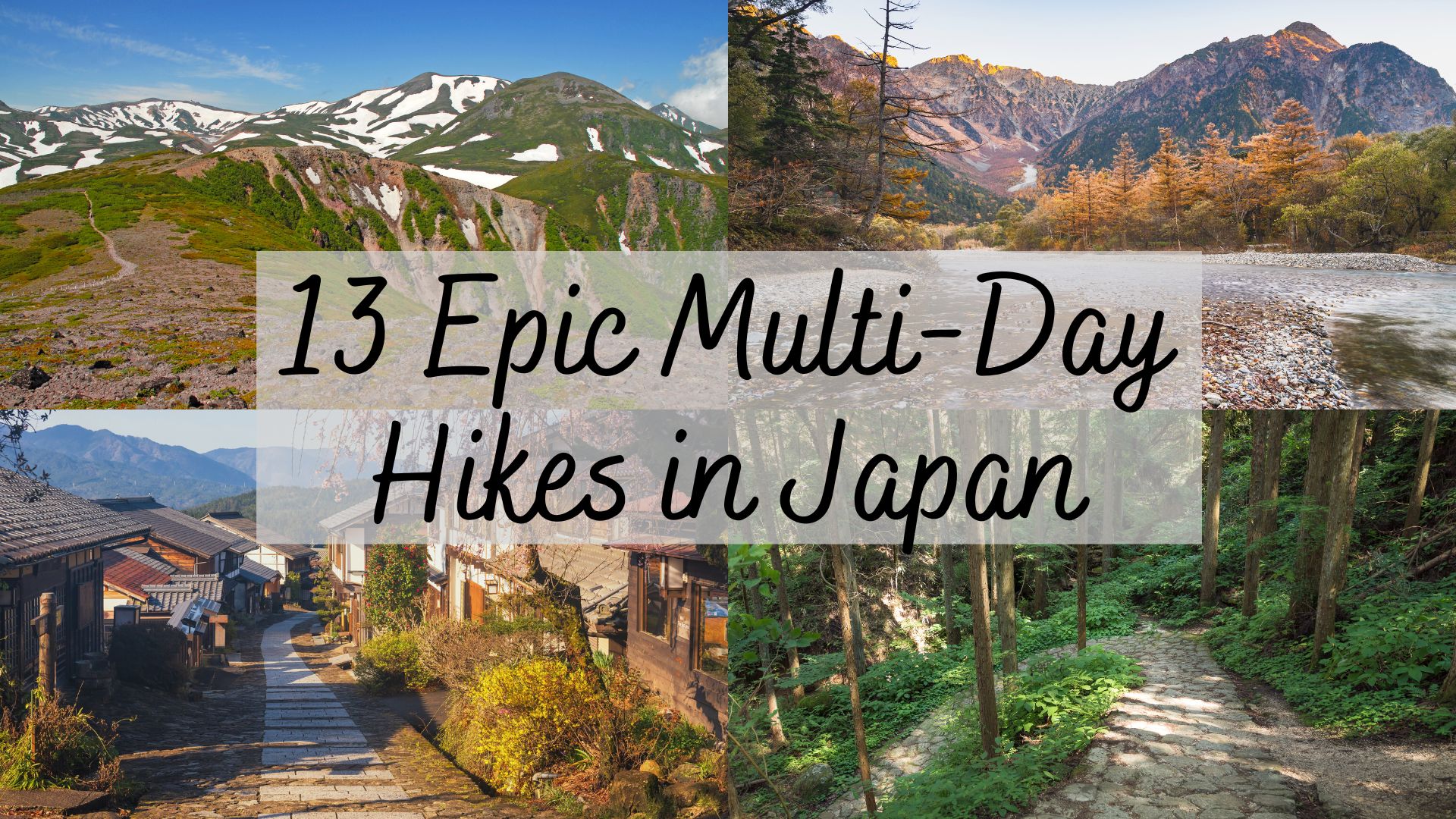
One thought on “Ultimate Guide to the Annapurna Circuit Trek”
Erika,
Happened across your blog today.Heading off to Annapurna Sanctuary in October.Did the Circuit in 2014 ,EBC in 2018, and the Markha Valley in 2019 .Really like your work and even though the Trek is 10 months away and we’re all in our 60’s,material like yours is getting me quite motivated. Hoping to do some walking in Japan in the future.Keep up the good work.